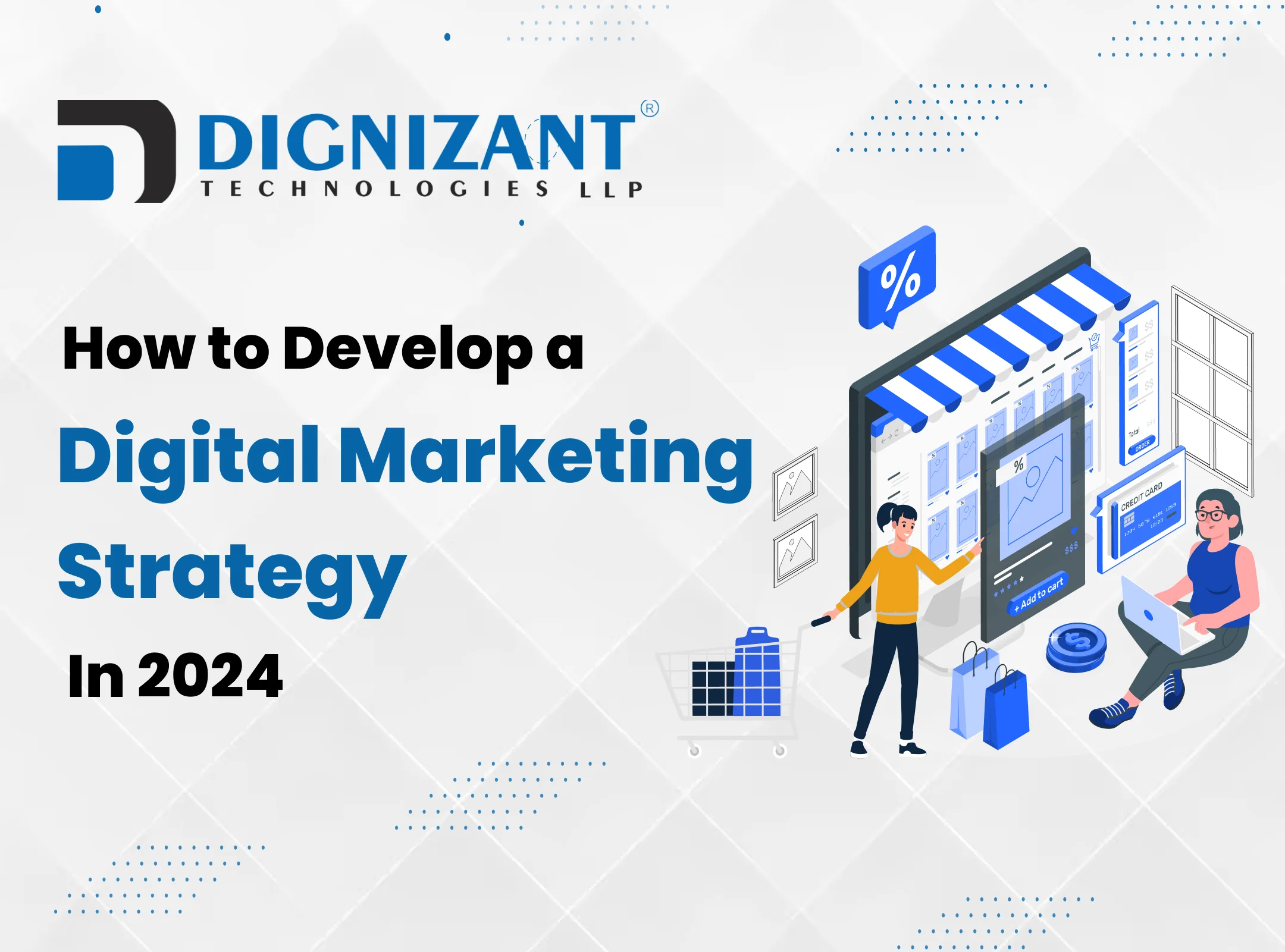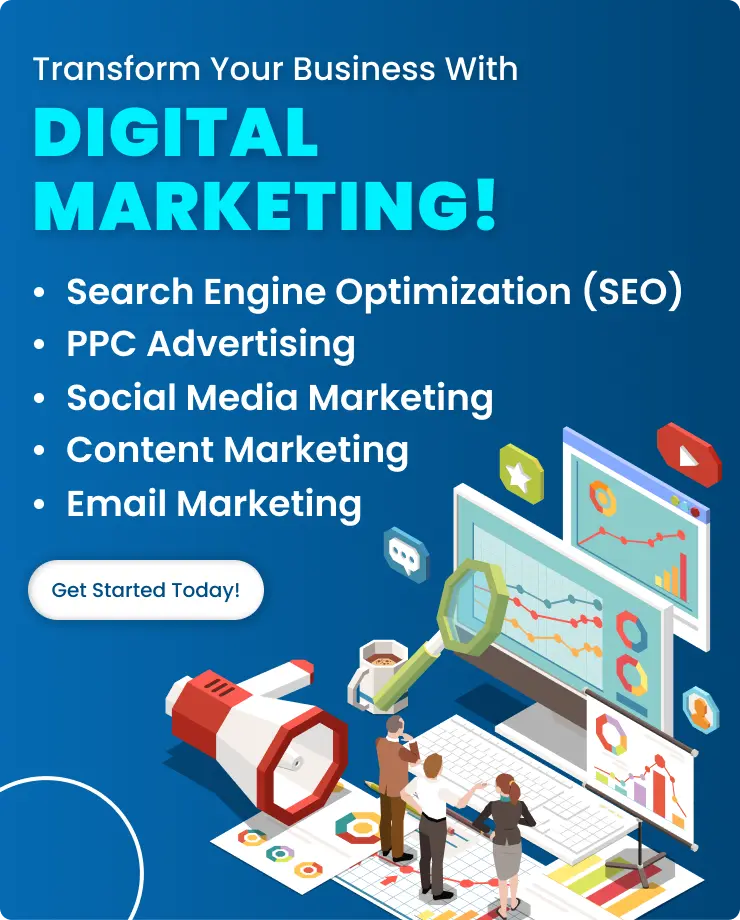A good digital marketing strategy is very important for businesses of all sizes in today’s fast-paced digital world. A well-planned digital marketing strategy can help you better your business and complete your objectives, whether you are trying to increase sales, generate leads, or build awareness of your business.
Developing an accurate digital marketing plan requires knowing your target audience, defining particular goals, and selecting the best channels to reach them. It includes creating valuable material, making the most of your online presence, and constantly verifying and updating your work.
As the best digital marketing company in India, we will take you through each step of developing the best digital marketing strategy in this blog. We will help you with anything from selecting suitable resources and channels to selecting your goals and understanding your target audience. Together, we will create a digital marketing strategy that increases your sales and improves your business’s reach.

1. Define Your Goals
Identify Objectives
The first and most important step in developing the most effective digital marketing strategy is identifying your goals. Whether your goal is to increase revenue, generate more leads, increase brand awareness, or improve interaction with clients, it all starts with defining it properly.
Your objectives should be smart, specific, visible, achievable, relevant, and time-bound to be effective. Instead of stating just “increase website traffic,” for example, make your goal to “increase website traffic by 20% in the next six months.” To guarantee that your advertising strategies match your overall business goals, make sure these goals are in line with them. Set these objectives in order of importance and focus your resources on the most important tasks first, laying the structure for your plan.
Set SMART goals
It’s like providing a clear road map for your dreams when you set SMART goals. Important qualities are linked to each letter in SMART. Firstly, it is important to have an exact goal. Make sure you know exactly what you would like to achieve. It should then be measurable so that you can monitor your development and determine when you’ve achieved your goal.
Next, determine if it is achievable, meaning that even with limited resources, it can be achieved. Also, your goal needs to be relevant to your general goals and advance you toward your greater vision. In the end, set a time limit for yourself to make it time-bound. This increases urgency and maintains attention. You’re setting yourself up for success when you set SMART objectives; it’s like having a straight path to your goals.
2. Understand Your Audience
Create profiles for consumers
Building customer profiles involves developing in-depth pictures of the market you want to target. You can better understand who your ideal clients are, what drives them, and how to connect with them by creating buyer characters, which are these profiles. Use market research, surveys, and consumer data analysis to create details about demographics, interests, behaviors, issues, and preferences to develop these profiles.
Gaining a deeper understanding of your customers will enable you to better target your marketing messages, strategies, and product offerings to fulfill their needs and wants. This will increase the efficiency of your marketing campaigns and increase your company’s success.
Check User Information
Checking and verifying user-provided data is an essential stage in the process of checking user information. The information collected is known to be correct and reliable through this method, which is required for efficient communication and customized campaigns.
To maintain the privacy of data and improve the user experience, organizations can find and fix any errors in user information, such as mistakes in spelling or incomplete details. Verifying user information ensures that it follows privacy laws and helps stop fraud. All things considered, this procedure is necessary for building client confidence and optimizing promotions through the use of accurate information.
3. Conduct Competitive Research
Identify Competitors
Identifying competitors in your market or specialty requires research and assessment of other companies or groups that provide similar services or products. You can learn a lot about your competitors’ advantages, disadvantages, strategies, and position in the market by getting to know them. Conducting market research and examining other websites, goods, costs, promotions, and client comments are common steps in this procedure.
By identifying your competitors, you can create plans to obtain a competitive edge, compare your performance, and find areas where you can separate yourself. In the end, this information gives you the ability to make wise choices and improve your business plans to better serve your target market and maintain an advantage over competitors.
Analyze Their Strategies
Understanding the methods and techniques businesses use to achieve their objectives is part of the strategy analysis process. This approach involves looking at factors including distribution methods, price plans, product offers, marketing campaigns, and consumer engagement programs.
Businesses can obtain important insights about market trends, consumer preferences, and areas of strength and opportunity by examining the strategies of their competitors. Making decisions, identifying best practices, and creating more successful business plans are all helped by this information. Also, by examining others’ strategies, companies may remain open and receptive to shifts in the market, which finally positions them for success.
Find Opportunities
Finding options means discovering where, in your market or industry, your company could grow and develop. Researching customer behavior, market trends, competitor problems, and new developments in technology or innovation are all required for this method to work. Businesses might find unexpected customer demands, specific audiences, or unexplored market sectors by looking at these elements.
Finding chances includes coming up with new concepts and making plans to take advantage of these decisions. Taking advantage of opportunities helps companies stay competitive, innovate, and achieve sustainable growth. Examples of these opportunities include launching a new product or service, entering new markets, or reducing current processes.
4. Choose Your Digital Marketing Channels
Website
A website acts as a company’s or individual’s online location, providing users with goods and services as well as information. It offers a single platform for online engagement, communication, and achieving a range of company goals. Websites progress to draw and hold visitors, establish trust, and encourage conversions with well-crafted layouts and content.
They are essential for building a web presence, promoting client communications, and reaching a wider audience in the age of technology. In today’s linked world, websites can become useful tools for attaining success with the proper design and maintenance.
Content Marketing
To draw in and keep a target audience, content marketing is a type of digital marketing technique that focuses on coming up with useful, on-time, and consistent information. Some formats, such as blog entries, articles, films, infographics, and social media posts, can be used for this content.
Instead of simply advertising a good or service, the main objective of content marketing is to offer value to the audience by speaking to their needs, interests, or problems. Through the provision of educational and interesting content, companies may build relationships with their audience, develop their reputation, and win their trust, all of which will eventually increase customer engagement and loyalty.
SEO (Search Engine Optimization)
The process of improving a website to increase its visibility and ranking in search engine results pages is known as SEO, or search engine optimization (SERPs). Increasing a website’s relevance and value in the eyes of search engines like Google, Bing, and Yahoo includes a variety of methods and techniques.
This includes creating high-quality backlinks from reliable sources and optimizing the technical aspects, meta tags, and content of websites. Businesses may boost their online presence, engage more organic visitors, and ultimately boost revenue and conversions by improving their website’s SEO.
Social Media Marketing
Using social media sites like Facebook, Instagram, Twitter, LinkedIn, and others to engage with your audience, increase awareness of your company, and achieve other business goals is known as social media marketing. It includes a variety of tasks like producing and sharing interesting content, interacting with followers, managing promoted advertising campaigns, and examining performance indicators.
Understanding your target demographic and selecting the best platforms to reach them on is essential for social media marketing success. Businesses may create leads and sales, improve website traffic, and build strong connections with customers by using the power of social media platforms.
Paid Advertising
The process of promoting goods, services, or information via paid channels, including search engines, social media sites, advertising networks, and others, is known as sponsored marketing. To reach particular audiences based on demographics, interests, behaviors, and other characteristics, it involves creating and running targeted advertising campaigns.
Through paid advertising, businesses may raise their profile, improve website traffic, and quickly turn leads into sales. It can come in a variety of forms, including sponsored content, display ads, video commercials, and search ads, giving advertisers the freedom to select the one that best fits their needs and budget. Businesses can increase their reach, more efficiently target potential customers, and achieve concrete advantages by investing in paid advertising.
Email Marketing
Sending emails to a specific audience to promote products, services, or data is known as email marketing. It seeks to develop and maintain client connections, develop leads, and increase conversions. Engaging content, calls to obvious action, and customized interactions that are frequently divided based on user behavior or preferences are all components of successful email marketing campaigns.
Marketing managers may monitor the success of campaigns, track performance, and increase engagement rates with the use of tools like email automation and analytics. Businesses can connect directly with their audience, send specific messages, and promote new business and consumer loyalty by utilizing email marketing.
5. Build a Content Strategy
Schedule of Contents
A content timetable, also referred to as a schedule of contents, is a practical tool used in content marketing to plan, manage, and coordinate the creation and delivery of content within a specified time. It specifies the kind of content that will be released, when it will be available, and on what platforms.
This timetable helps in providing similarity, prompt delivery, and coordination with campaigns and goals for marketing. A schedule of contents gives teams a clear path forward, allowing them to plan, stay organized, and monitor their progress. Regular delivery of relevant information enhances audience engagement and enables better use of resources and content planning.
Types of Content
In digital marketing, “types of content” refers to a variety of forms that are used to effectively engage clients and deliver messages. These include social media posts that promote loyalty and community building; blog posts that offer in-depth information and insights; videos that offer images and dynamic stories; infographics that present data and information visually; eBooks and documents that offer in-depth knowledge and research; blogs that offer audio content for on-the-go watching; and updates that keep audiences informed regularly. With a variety of content techniques, each type helps organizations connect with and reach more people by satisfying specific requirements and appealing to different audience preferences.
SEO Implementation
The implementation of SEO involves putting strategies and methods into practice to raise a website’s visibility and position in search engine results pages (SERPs). This procedure entails adding pertinent keywords to the content of the website, optimizing the navigation and structure for a better user experience, getting high-quality backlinks from reputable sites, and making sure technical aspects like mobile friendliness and site speed are optimized.
To measure results and make informed decisions, SEO implementation can involve following and assessing website performance using tools like Google Analytics. Businesses may improve their online presence, draw in more organic visitors, and ultimately achieve their marketing strategy for online business goals by putting SEO methods into practice.
6. Optimize and Use Your Marketing Tools
Marketing Automation
The term “marketing automation” describes the process of using software and technology to increase accuracy and efficiency by automating regular marketing tasks and flows. This includes lead management, social media posting, email campaign automation, and targeting clients. Businesses can watch customer activity, evaluate campaign results, and provide timely, targeted communications to their audience through marketing automation.
This enables marketers to increase engagement, focus on important initiatives, and increase conversion rates. All things considered, marketing automation simplifies marketing initiatives, saving time and money while enhancing the impact and consistency of marketing communications.
Analytics Tools
Software applications called analytics tools are used to collect, manage, and analyze data from many types of digital marketing campaigns. Businesses can use these tools to track key performance indicators, or KPIs, such as site traffic, user behavior, conversion rates, and campaign efficacy. Examples include social media analytics tools like Facebook Insights and Twitter Analytics, which measure engagement variables, and Google Analytics, which offers insights into the operation of websites.
Marketing may make data-driven choices, improve their strategy, recognize patterns, and calculate the return on investment of their campaigns using analytics tools. This makes it possible to target more effectively and continuously improve, which eventually leads to the overall performance of the company.
7. Create a Budget and allocate Resources
Set Your Budget
A good marketing strategy requires careful planning and budget control. It means working out how much money you can spend on your marketing efforts over a given period. This budget should handle spending. such things as advertising, content production, software tools, and any outsourced services. You can allocate your resources, focus your marketing efforts, and stop overpaying by creating a clear budget.
Additionally, it enables you to calculate the ROI of various campaigns and optimize spending by making data-driven changes. A well-defined budget guarantees the sustainability of your marketing initiatives and is consistent with your company’s objectives.
Allocate Resources
Effectively allocating your resources, including workers, money, time, and technology, to different activities and projects inside your company is known as resource allocation. Providing funds effectively guarantees that each aspect of your business operations gets the support it needs to run smoothly and meet goals.
This procedure involves setting priorities for tasks according to their importance and possible influence, providing sufficient talent and funding for important initiatives, and distributing responsibilities to prevent overwork.
8. Create and Analyze Your Campaigns
Put Your Plan Into Action
Delivering your plan means carrying out the actions and plans that you set out in your marketing or business plan. To complete this step, you must organize your team, assign resources, set deadlines, and put your developed strategies into action.
It also involves being updated on progress, making required adjustments, and verifying that every action is in line with your main goals. Clear communication, concerted efforts, and continual assessment to quickly address any problems are necessary for successful operation. By actively carrying out your strategy, you transform your strategic concepts into visible results and get your company close to its goals.
Review Performance
Analyzing performance means comparing the effects and success of your business or marketing efforts to set standards and signs. Key performance indicators (KPIs), including website traffic, rate of conversion, sales numbers, customer satisfaction ratings, and return on investment (ROI), are analyzed in this step.
Businesses can find areas for improvement as well as their strengths and weaknesses by regularly reviewing performance. The use of data to make choices is made possible by this approach, which permits tactics and methods to be modified if necessary for better outcomes.
9. Analyze and Optimize
Results Review
Analyzing the outcomes and effects of plans and initiatives that have been put into effect within a business or marketing sector is known as a results review. It includes evaluating measurements and key performance indicators (KPIs) to determine how well the best digital marketing campaigns, projects, or overall business performance are working.
Organizations may find areas that require improvement, successful places, and chances for optimization by carefully evaluating results with set targets and standards. The process of reviewing results enables firms to make data-driven decisions by refining their plans, moving resources, and shifting them as needed to improve future results. In the end, this regular evaluation guarantees ongoing development with broad goals, promoting sustainability.
A/B Testing
In marketing and web optimization, A/B testing, also known as separate testing, tests two versions of a website, email, or advertisement to see which one works better. In this approach, two versions (A and B) with a single difference, for example, in the structure, call-to-action, or headline, are made and then distributed at random to consumers.
Businesses may determine which version performs better and make data-driven decisions to maximize their marketing efforts by tracking user engagement, conversion rates, or other important signs. A/B testing works by continually improving and optimizing marketing materials based on real-time input, which helps to improve overall performance, increase conversion rates, and improve the user experience.
10. Continue to Learn and Improve
Keep Learning
“Never stop learning” is a never-ending method of taking up new information, abilities, and views to stay current and relevant in a world that shifts easily, whether it be business, technology, or industry trends. To adjust to change, overcome limitations, and accept chances, this approach entails looking for educational opportunities, maintaining curiosity, and promoting continuous education.
Individuals and organizations can maintain their speed, creativity, and efficiency by making continuous investments in personal growth and education. This will help them stay ahead of the line, grow, and succeed in their objectives.
Conclusion
In short, developing an ongoing learning mindset is important to stay ahead of other people in the changing world of today. Individuals and businesses can overcome challenges, benefit from development and success chances, and adapt to changing conditions by consistently seeking out new knowledge and skills. Remember that learning is a lifelong process that enables you to advance, create, and succeed in every project you choose. It doesn’t stop when you achieve a goal. Keep learning, remain interested, and never stop exploring!
Frequently Asked Questions (FAQ)
What are the best digital marketing strategies in 2024?
The best strategies include content marketing, social media marketing, SEO, PPC advertising, email marketing, and influencer marketing. Each has unique benefits and can be tailored to your business needs.
How do I identify my target audience for digital marketing?
Use tools like Google Analytics, social media insights, and customer surveys to gather data. Create detailed buyer personas to understand their needs and preferences.
Why is SEO important for digital marketing?
SEO improves your website’s visibility in search engine results, driving organic traffic and enhancing your online presence. It’s essential for long-term success.
How can I measure the success of my digital marketing strategies?
Use analytics tools to track key metrics like website traffic, conversion rates, and social media engagement. Regularly review and adjust your strategies based on the data.
What future trends should I consider for my digital marketing strategy?
Stay ahead by keeping an eye on trends like artificial intelligence, voice search, and augmented reality. Adaptability and staying informed are crucial for success in digital marketing.

Stay Up to Date
Get our newsletter

Table of Contents
Toggle- 1. Define Your Goals
- 2. Understand Your Audience
- 3. Conduct Competitive Research
- 4. Choose Your Digital Marketing Channels
- 5. Build a Content Strategy
- 6. Optimize and Use Your Marketing Tools
- 7. Create a Budget and allocate Resources
- 8. Create and Analyze Your Campaigns
- 9. Analyze and Optimize
- 10. Continue to Learn and Improve
- Conclusion
- Frequently Asked Questions (FAQ)





